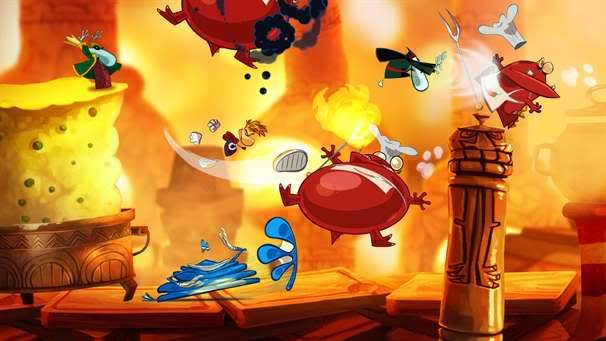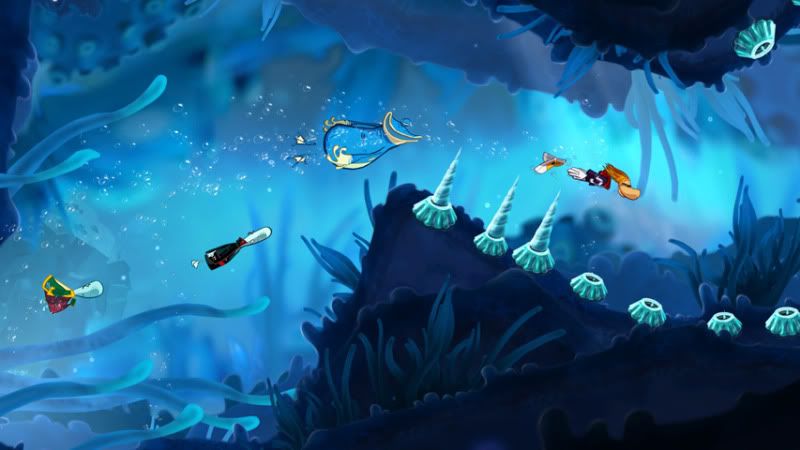This season has been bountiful with games — an onslaught of quality year-end releases that has pushed many players to joyful bankruptcy. Yet with all the festive frenzy, one poor, deserving game has fallen by the wayside, a game whose performance may very well influence the creative future of the industry.
Rayman Origins is a critically adored 2D platformer with a whimsically oddball style that coats well-composed level design. This title is, quite frankly, a joy to play, but according to sources, only 50,000 copies were sold in its first month.

I can't begin to describe what's going on here, but I assure you it's glorious.
You can easily blame these criminally low numbers on Origins getting lost in the holiday shuffle, but it's worth asking: Of all releases, why this one? Rayman isn't exactly in the top tier of mascots, but the brainchild of Michel Ancel has held his own pretty well if merely by the fact he's not occupying some circle of gaming hell with Bubsy and Blinx: The Time Sweeper. Recognition is there, as are the glowing reviews and some good deals on Black Friday (which I took advantage of). So why did this game get overlooked?
Do we just not give 2D platformers the same recognition we used to?
Oh sure, we still have the kings, Mario and Sonic, hanging around, but they just can't seem to stay out of 3D (for better or worse). And their modern 2D offerings tend to get treated as nostalgic sidelights rather than main entries to their series. Donkey Kong Country Returns did relatively well for itself, but calling it a blockbuster is tough. The only other character who seems to remain consistently 2D is Kirby, and bless his little pink soul for it.
Back in the Super Nintendo and Genesis days, 2D platformers were in abundant supply. We experienced masterpieces, but we also saw a slew of copycats that just didn't provide as satisfying of an experience. You couldn't swing a Super Scope without hitting some me-too critter with obnoxious '90s attitude and a set of phoned in stages to stumble through. Poor controls and redundant design killed a lot of these titles. They also might make us subconsciously gun shy when even a semi-familiar friend returns in 2D — or at least make us think a game is not beefy enough to warrant a price similar to its 3D brethren.

Take in the animation and ambiance of this scene, and it's as engaging as any 3D world out there.
Check out the screenshots in this piece. I wouldn't be surprised if they remind you of Earthworm Jim (if you were around to play it). That game also had a unique character and an incredible art style. But honestly, I didn't really consider it that much fun to play. It has its fan base, but the series is kaput and is now the fodder of iPhone ports and a maybe-one-day comeback.
Origins might be the same, right? The title might be another classic-style platformer featuring a character fading into the mists of obsolescence, flailing in a desperate, yet mediocre, attempt to achieve relevance.
No. We must not allow ourselves to treat the terms "classic," "artsy," and "2D" as remnants of a bygone era restricted to handheld-only modern appearances. To do so would deny us of the amazing experiences that result when someone manages to combine all those crucial elements correctly. The 2D style allows for certain artistic and mechanical concepts to be employed more effectively than 3D. Creators and developers can flourish much more brilliantly on a flat plane. As methods evolve, both 2D and 3D can continue to benefit from each other's breakthroughs.
Please try Rayman Origins. Now more than ever, the gaming industry needs to put its money behind artistic and creative exploration. An ocean of indie developers with the potential to do extraordinary things is out there just waiting for the green light. And when something as right as Rayman Origins comes along, all the important people are watching.
VentureBeat's mission is to be a digital town square for technical decision-makers to gain knowledge about transformative enterprise technology and transact. Learn More
